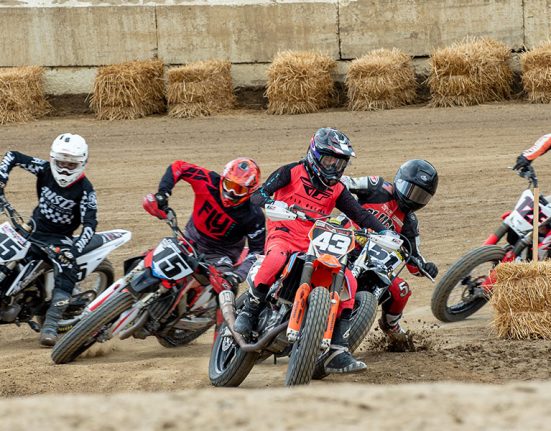Reasons to Ride
On the fence about giving two wheels a try? You’re in the right place!
Riding a motorcycle is not intuitive. The technical skills required to manage the unique physics of a single-track vehicle, and to carefully execute braking, turning and accelerating maneuvers all while maintaining balance, are challenging no matter what your gender. The best way to learn properly is to enroll in a certified rider training program. Women are already one step ahead of men in this realm, as statistics show that women riders are significantly more open to receiving expert guidance. According to the Motorcycle Safety Foundation, around 30 percent of students who enroll in its Basic RiderCourse are women, even though women make up a smaller percentage of total motorcyclists. Not only are women more likely to enroll in this intensive training program, but they are more likely to complete the training, too. Women are also more likely to participate in continuing education and advanced rider safety courses (58 percent of women riders, compared to just 44 percent of men, regularly enroll in advanced training courses). This openness to continued learning and the attitude of lifelong learning on the part of female riders is reflected in safer riding statistics: 91 percent of motorcyclists killed in crashes in 2013 were male, suggesting that female riders overall are safer riders.
When it comes to riding, everyone starts at the beginning. Proper training will take you through all the steps necessary to learn to ride, starting with the basics. All riders learn at their own pace, and once you have a clear understanding of the basic fundamentals, it’s easy to practice each individual skill at your own pace and make your own progress. The important thing is to take that first step and sign up for a certified training course — even if you already know how to ride.
Having the right equipment is essential to feeling confident in the saddle, and this starts with having the right bike. (Read our guide to selecting the right motorcycle here). Once you’ve selected your perfect motorcycle, make sure that it fits you as well as possible. Do you feel comfortable in the saddle? Can you put both feet firmly on the ground? Do all the controls fall easily to your reach? Comfort is everything. If you are comfortable, you will be relaxed; if you are relaxed, you will ride better. Make sure that everything on your bike is adjusted to fit you, and if something doesn’t feel right, change it. Most saddles can be swapped out for a lower-profile option, or even cut down to bring you a few inches closer to the ground. Rear suspension lowering links are an easy and economical way to lower almost any bike, and fork lowering kits are available for most telescopic forks, too. There are many options to reposition the handlebars closer — or higher, or lower — and foot pegs can often be relocated, too. Motorcycles are not one-size-fits-all. Take some time to fine-tune your bike to fit your body and you’ll feel more comfortable and more confident, too.
The same goes for riding gear. You want to make sure your gear fits your body, so it isn’t bunching, billowing or otherwise misbehaving in a way that distracts you when you are riding down the road. This is relatively easy now that there is an ever-increasing variety of riding gear made specifically to fit women (Read our guide to selecting the right riding gear here). But it’s equally important to make sure the gear you’re wearing is suited for the type of riding you’re doing. If you’re participating in a track day, you’ll want gear that prioritizes protection and freedom of movement. If you’re commuting to work or school, you might want gear that is designed to comfortably be worn over regular street clothes. If you are headed out on a backcountry discovery route, you’ll want versatile gear that is weatherproof and ready for dirty or muddy conditions, and perhaps has some options for carrying cargo or a hydration system, too. No matter what type of riding you do there is gear specifically engineered to make your experience better. Get geared up.
The thought of controlling a big and heavy machine like a motorcycle can be intimidating. “What if I can’t handle it? What if I drop it?” It’s natural to ask questions like these, especially in a male-dominated activity like motorcycling, where you might not see many other female role models showing you it can be done. The reality is that a person’s physical size or strength does not have to be a limiting factor when it comes to riding a motorcycle. Once you know the proper techniques, almost any person — male or female — can ride almost any motorcycle in almost any riding conditions. More often than not, it’s just a matter of having confidence.
When it comes to success, confidence matters as much as competence — and evidence suggests that women are less self-assured than men. Men tend to overestimate their talents everywhere; women, on the other hand, tend to underestimate their talents and abilities, whether it’s in the workplace, in academia, or behind the handlebars of a motorcycle. Riding a motorcycle is 90 percent mental and 10 percent physical. You are likely better and more capable than you think you are, so the first step is to start thinking like that.
What are some simple and practical things that you can do to increase your confidence on the bike? Invest in additional training, to build your skills. Seek support from mentors and believe them when they tell you that you are doing something well. Learn how to pick up your bike after you drop it. You will drop your bike, and knowing what to do when that happens will replace that fear with additional confidence. Learn how to do basic maintenance on your motorcycle, as well. Read the owner’s manual, and don’t be afraid to change the oil, adjust the chain, and do other simple maintenance tasks. The better you know and understand how your motorcycle operates, the more comfortable and confident you will be around it.
Finally, adjust your internal narrative to support your belief in yourself. Stop the negative self-talk and silence your inner critic that stops you from taking chances. Don’t be careless, but also don’t be afraid or unnecessarily over-cautious. Cultivate a can-do attitude and just go for it, whether “it” is an over-night ride, a challenging single-track trail, or just riding on the expressway for the first time. Confidence isn’t not being scared — it’s doing something in spite of feeling a bit of fear, knowing that whatever happens, you are prepared to deal with it.
There’s only one person in control of your motorcycle, and that person is you. Even when you are riding with a group, you need to have the confidence to ride your own ride and not be pressured into riding beyond your skill level. You need to have the self-assurance to make your own decisions, to ride at your own pace, to know and respect the limits of you and your bike, and not to let peer pressure influence your actions.
What’s right for another rider is seldom going to be right for you, so it’s important that you work at your own speed to build skills and confidence. Riding alone is crucial in the beginning to help you understand where your boundaries are — you select the roads, you set the pace, you learn where your own comfort level is. But even after you build confidence riding alone and graduate to riding with others in small groups, it’s still essential that you always remain within your comfort zone. Don’t push your pace just to keep up with faster riders; if they are worth riding with, they’ll be waiting for you at the next turn. If the road (or trail) is more challenging than what you are ready for, find a short-cut or work-around, or simply turn back and reconnect with the group at another spot. Good riding buddies will accommodate any of these adjustments to the ride pace or route, and if your fellow riders give you any trouble, that’s a note that those are not the folks you want to be riding with. Ride your own ride and ignore anyone who pressures you to do otherwise.
One of the best ways to build riding skills, gain motorcycle knowledge, and get more comfortable on your bike is to find a motorcycle mentor to aid and assist you on your motorcycle journey. Find a friend who has many more miles under their tires than you do and then lean on that friend for advice to help you avoid the most typical mistakes made by new riders. Whatever challenge you might be worried about — riding in the rain, your first ride on an interstate, packing for your first overnight motorcycle trip — it’s so much easier when you have a trusted friend by your side who can help guide you through the experience for the first time.
How do you meet other like-minded riders? One of the best ways is to join an AMA-charted riding club, most of which are filled with serious motorcycle enthusiasts who are dedicated to growing the sport of motorcycling and promoting safe and fun two-wheeled activities. Attending motorcycle events, and being open to conversations, is another great way to meet fellow riders with common interests. Just be sure that they have the right personality to promote your skills and growth without being pushy. The two most important qualities a moto-mentor can possess are empathy and patience; without the ability to put themselves in your shoes, and the patience to help you figure out what works for yourself, a mentor is more likely to create stress than success.
A good mentor will take the extra time to learn where you are mentally, what you know, where you want to get to next, and how to help take you there. Focusing on where you want to go as a rider and then taking small steps to build the skill and confidence to get you there is what makes you a better rider — and having a mentor to help you through this process can be an invaluable help.
AMA-Sanctioned Events
Search for AMA-Sanctioned events by city, state, event type and date range.






